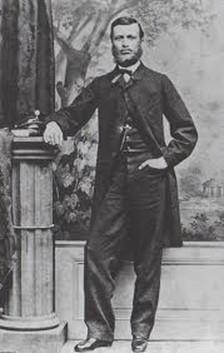
LJUBOMIR KLERIĆ (born Julius Clery, Subotica, June 29, 1884 – Belgrade, January 21, 1910), mining engineer, geologist, scientist, constructor, inventor, founder of the Serbian School of Mechanics and Mechanical Engineering, university professor, is one of the first academicians of the Serbian Royal Academy (today Serbian Academy of Sciences and Arts). Versatile and highly educated mining engineer, a great figure in Serbian science, Klerić belongs to the creators who open and build new roads in engineering science. His scientific and professional work in mining, geology, mechanical engineering, mathematics, mechanics, telemetry and analog computing is a testament thereto.
Education
He received his primary education in Subotica in 1855, and secondary in Belgrade, having finished the First Men’s Gymnasium in 1863. After the second year at the Technical Faculty of the Belgrade Great School, in 1865 he was sent to study mining engineering at the Royal Saxon Mining Academy at Freiberg, where he completed his studies in 1869. During his studies, 1867-1868, he studied mechanical engineering at the Faculty of Mechanical Engineering of the Federal Polytechnic Institute in Zurich. He further studied in 1870 at the Royal Mining Academy of Berlin.
Mining and geology
He explored the mercury deposit and opened a mine on Avala, investigated the condition of the ore deposit on Venčac, Rudnik and Kosmaj, geological conditions on the route of the Ćuprija – Aleksinac railway, as well as iron deposit near Oran in Africa. On behalf of the Government of Serbia, he controlled the project and testing of stone quality for the construction of the Sava Bridge in Budapest.
Mathematics and mechanics
Klerić’s published scientific papers, the first from 1872 and the last from 1907, are thematically mostly from the application of mathematics and mechanics. He is the author of numerous scientific papers and discussions, the textbook Theoretical Mechanics (three books, Belgrade, 1880, 1883, 1888, 1317 pages) and two monographs: Current results in kinematics as a contribution to my theoretical mechanics (Belgrade, 1882, 47 pages) and Tractoriograph – construction of Ludolph number π and base e of natural logarithms (Belgrade, 1896, 316 pages)
University activity
At the Great School, he was elected professor of Mechanics and Machine Science, and with the division of the subject he took over Theoretical Mechanics. He also founded two departments at the Great School: descriptive geometry with projective geometry and graphostatics and dry and water construction. He was the dean of the Technical Faculty of the Great School in Belgrade, a member of the Committee for the Establishment of the University of Belgrade, etc.
Constructor and inventor
He is the designer of soil drilling machines, blasting cartridges, underwater mines, tractoriograph, telemeter, polar pantograph, second-order line drawing instrument. Self-critical and responsible, he subjected his design solutions and inventions to the tests, criticisms and assessments of the
scientific and professional public. Those were in most cases presentations at the Academy of Natural Sciences of the Serbian Royal Academy.
Engagement in public administration
Conservative by political conviction, Klerić was never a member of a political party. As a patriot dedicated to the progress and rebirth of a poor country, he twice accepted to help the country with his expertise, skills, reputation, authority and knowledge, as a minister of: Education 1894-1895 and National Economy 1896-1897. He was a member of the State Council from retirement to the end of his life.
Patriot and soldier
As a mining engineer skilled in explosives and blasting, he responded to the call of the Minister of Army to assist in combat operations in the Serbo-Turkish wars (Serbian Wars for Independence) 1876-1878. Along with Sima Lozanić, a chemist, he took part in combat activities. They made and laid underwater mines on the lower Danube and on the Morava. He also set up impediments with minefields, to keep Turkish ships and cavalry away. He was awarded two orders for war merits.
Klerić and famous contemporaries
He had friendship, respect and productive creative cooperation with many famous contemporaries. What especially stands out is his cooperation with academicians Josif Pančić, Jovan Žujović, Sima Lozanić, Bogdan Gavrilović, Mihajlo Petrović Alas. The relations between Milutin Milanković and Ljubomir Klerić were not as we would expect them to be. Understanding the significance and greatness of Nikola Tesla’s scientific work, he proposed in 1894 to the Serbian Royal Academy to elect Nikola Tesla as a corresponding member.
Reputation and recognition
He had received numerous awards for his contributions to science, engineering, education, patriotism and other engagements: For war merits, he was awarded the Medal for Courage and the Order of the Cross of Takovo; He was the recipient of the Order of Leopold of the Kingdom of Belgium; Member of the Serbian Learned Society-Committee for Natural and Mathematical Sciences, 1871; Member of the Serbian Royal Academy, 1887; Member of the Hungarian Academy of Sciences, 1894; Member of the Serbian Agricultural Society, 1872; Honorary member of the Serbian Medical Association, 1878; Honorary member of the Association of Serbian Engineers and Architects, 1890; Member of the Serbian Geological Society, 1891; Member of the Board of the Mining Association of the Kingdom of Serbia, 1895; Member of the Supervisory Board of the Serbian Shipping Company, 1895, etc.
Slobodan Vujić
More about Klerić (only in Serbian) on the website:
LIBRARY / BULLETIN OF MINES 2019
( https://ribeograd.ac.rs/en/bulletin-of-mines-2019/ )

